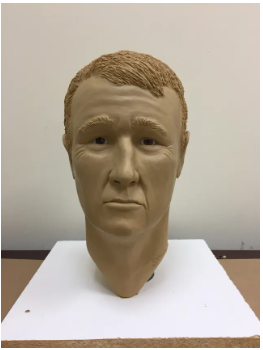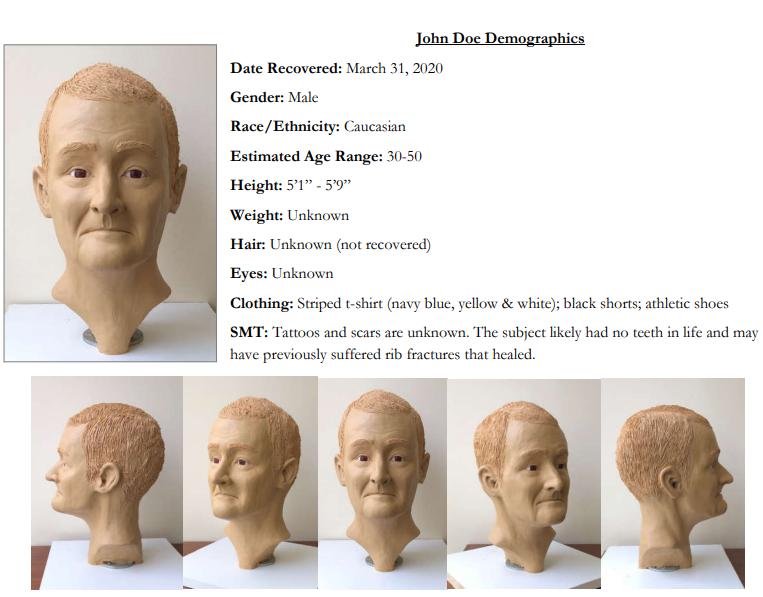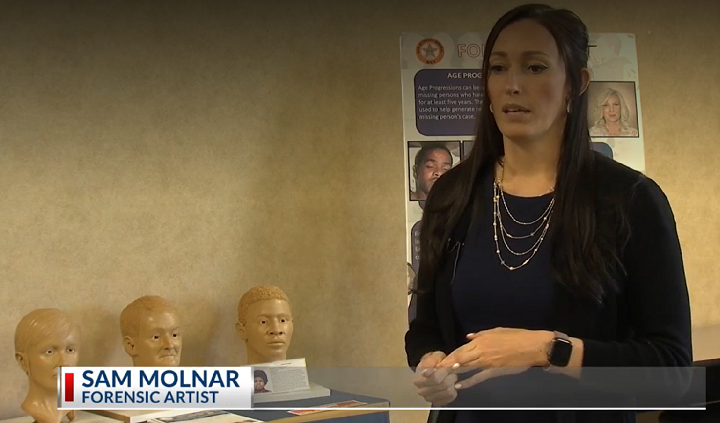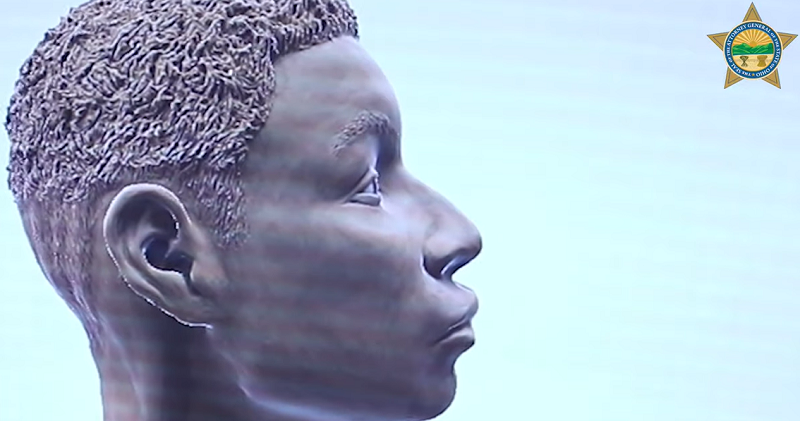Human Remains Could Be Identified with the Help of Forensic 3D Printing
I’m still in awe at what additive technologies can accomplish, from creating alternative meats, automotive parts, shoe insoles, and surgical models, to giving faces to the lost. That is to say, they can be used for facial reconstruction, whether it’s putting a face to a long-dead historical figure or helping to solve a cold case. A few years ago, I wrote about a cold case in Ohio, not far from where I live, where 3D printing and facial reconstruction were used to help identify a deceased woman, and put her alleged killers behind bars. Since then, Ohio’s Bureau of Criminal Investigation (BCI) has continued to use the technology, partnering with The Ohio State University to identify human remains. But now, the process has been improved to be a lot quicker, thanks to animation technology.
At a recent press conference in Stark County, Ohio Attorney General Dave Yost announced these new advancements in forensic facial reconstruction.
“Our hope with this new technology is to give law enforcement and the public alternative images of unidentified persons to generate more leads and expand the possibilities of solving the case.”
Sometimes, when dealing with unidentified remains, all detectives have to work with is a skull, and that’s not even always fully intact. When DNA, dental records, tattoos, or identifying marks aren’t available, that’s when they call in someone like Sam Molnar, a forensic artist and intelligence analyst for BCI, to determine what the person looked like when they were alive.
Molnar said, “I liked to do art as a kid and I watched way too many crime shows as a kid. And I always wanted to do this.”
Relying on specialized training from the Center for Missing and Exploited Children in Florida, and using information from anthropologists, including estimated gender, age, and race, she helps create the heads and faces of these unidentified people, sculpting hair, facial features, and muscles out of clay on top of 3D printed copies of their skulls.
“So I’ve been to several trainings where I’ve learned how to do facial reconstruction from a skull. I just, I have like a book that I follow,” she explained at the press conference. “So there’s different, average tissue depth markers for different places in the skull. And then it’s also dependent upon like the crime scene report, the anthropology report.”
Getting this 3D printed copy used to be a fairly lengthy process, which required driving the skull to OSU’s Wexner Medical Center in Columbus, having it CT scanned, and then delivering that file to the Digital Union at OSU, which offers free 3D printing and laser cutting, meeting spaces, access to high-end audio and video studios and the Adobe Creative Suite, and more. But, the file that results from the CT scan contains a lot of data, which adds time to the process as well.
“I would take that CT scan file, which has a lot of information you don’t necessarily need for 3D printing— when you think about what’s on the inside of a skull, the inside of a mouth — things like that, that aren’t necessary for (Molnar) to have the outer skull to sculpt on. It would usually take some time between three days to a little over a week to print a skull because it is a slow process to do that level of detail,” explained Amy Spears, the Manager of the Digital Union.
 Jane Doe #3067’s remains were found buried next to a playground on Glenwood Ave. in Cincinnati on May 31, 2018. She was wearing a gray tank top and gray pajama pants. She had brown and gray, medium-length hair that was fine and wavy. Investigators believe she had been resting by the playground for “a few weeks” before she was found, and that she was between 35 and 60 years old when she died. Anyone with information is asked to call the Hamilton County Coroner’s Office at (513) 946-8700.
Jane Doe #3067’s remains were found buried next to a playground on Glenwood Ave. in Cincinnati on May 31, 2018. She was wearing a gray tank top and gray pajama pants. She had brown and gray, medium-length hair that was fine and wavy. Investigators believe she had been resting by the playground for “a few weeks” before she was found, and that she was between 35 and 60 years old when she died. Anyone with information is asked to call the Hamilton County Coroner’s Office at (513) 946-8700.Obviously, the longer it takes to get the 3D printed copy of the skull, the longer it takes to kick these cold case investigations into high gear. But now, BCI detectives are making breakthroughs in cases that have been unsolved for years, thanks to a partnership with two other people on the OSU campus: graphics researcher Jeremy Patterson, a former video game designer, and immersive designer and 3D animator Dean Hensley. They never dreamed they’d be using their talents for forensics, but are excited to help with something so important.
“It’s being able to take your skills and your abilities and use the time that you have to be able to do something that can really help people,” said Patterson.
Patterson and Hensley developed a computer program that uses a process called photogrammetry to build a scaled 3D rendering of almost any object, including human skulls. Before the software was developed, this process used to be much more lengthy and complex.
“Traditionally, this took specialized equipment, equipment that was expensive,” Patterson explained. “You had to specifically stage an object to go through this, and the object itself mattered.”
Now, their program only needs a series of iPhone photos, taken from several angles, to build the rendering.
Henley said, “Anybody that’s got a cell phone that has high-quality images, they can make a 3D object in minutes.”
Molnar doesn’t need to drive from the BCI lab to OSU anymore to scan a skull; now, she just snaps images of the specimens on her cell phone and sends them to Hensley and Patterson, who quickly make the 3D model. Their file has far less data than traditional CT scans, which means it takes much less time to print a copy of a skull on the Digital Union’s UltiMaker system and get the image out to the public.
 John Doe #2027’s skeletal remains were found on January 8, 2016, inside an abandoned two-story house in Akron. Investigators say the house caught fire in 2012. He was found with two size XXL coats, three layers of pants and black shoes. He is believed to have been between 30 and 55 years old at the time of his death. If you can identify this person, call the Akron Police Department at (330) 375-2490.
John Doe #2027’s skeletal remains were found on January 8, 2016, inside an abandoned two-story house in Akron. Investigators say the house caught fire in 2012. He was found with two size XXL coats, three layers of pants and black shoes. He is believed to have been between 30 and 55 years old at the time of his death. If you can identify this person, call the Akron Police Department at (330) 375-2490.Spears confirmed that the process can work, explaining that “some of the ones that we’ve printed that have been identified have been people who have been unidentified for decades.”
“Once we get it done, we get a bulletin together,” Molnar said. “We usually work with the local agency to put together some sort of press release, blast it out to the public, and hope that somebody recognizes this person and calls in a tip that allows us to identify them.”
 Public bulletin for John Doe #3312, found in Stark County, Ohio
Public bulletin for John Doe #3312, found in Stark County, OhioThis technology doesn’t just speed up the process of creating the 3D printed skulls, either. It’s also used to create photorealistic digital images of what these unidentified persons might look like.
“We can change factors unknown to investigators, like skin tone, eye color, facial hair, and hairstyle,” Yost explained. “We could also do an age progression in cases where investigators don’t have a precise age for the remains.”
At the press conference, Yost was also joined by Stark County Sheriff George Maier and Stark County Coroner Dr. Ron Rusnak, and together they revealed a forensic facial reconstruction of an unidentified man whose remains were found in 2001 in Canton. Authorities say the remains were completely skeletonized and may have been at that particular location for several years. He is believed to have been a Black man, between 5 feet 4 inches and 6 feet tall and between 21 and 44 years old. No clothing was recovered with the remains, and other identifying details, like eye color and weight, are unknown.
 Public bulletin for second Stark County John Doe
Public bulletin for second Stark County John Doe“He was found just a couple of months after the twin towers were struck on 9/11, that’s how long this person has been waiting to be identified. Somebody somewhere knows him. People loved him. We need to help provide them closure,” Yost said.
Maier said that “we owe it to the victims in our community” to figure out what happened to them, and hopes the reconstruction will help with identification.
“I will tell you that most good police officers will tell you there’s nothing better than boots on the ground,” he said. “People on the ground developing leads, but without this type of assistance, we would not be able to do our jobs.”
Without the use of advanced technologies like CT scanning, 3D printing, and photogrammetry, improvements like this in forensic facial reconstruction would not be possible.
Subscribe to Our Email Newsletter
Stay up-to-date on all the latest news from the 3D printing industry and receive information and offers from third party vendors.
Print Services
You May Also Like
Low-cost “Suzy” Polymer Powder 3D Printer is Faster and Cheaper than Past Models
Polish laser powder bed fusion (LPBF) firm Sinterit has released a follow-up to its predecessors, Lisa and Nils, called Suzy, a $19,490 printer equipped with a 30W fiber diode laser....
India’s $58M Space Fund Is a Boon for AM Innovation
India’s space industry is picking up serious momentum. With a projected $44 billion space economy by 2033, the country is aggressively expanding its capabilities, fostering private-sector participation, and reducing its...
Japanese Advanced Manufacturing Capabilities Grow in Europe with Sodick’s Purchase of Prima Additive
The global economy is currently undergoing a reshuffling in terms of what gets manufactured where. In large part, this trend is being driven by new geopolitical alliances and the need...
Bosch Invests €6M into Serial Auto Part 3D Printing
German industrial conglomerate Robert Bosch GmbH, the world’s largest supplier of automotive parts, has announced a new investment into Nuremberg, Germany additive manufacturing (AM) facility. The nearly €6 million in...





























